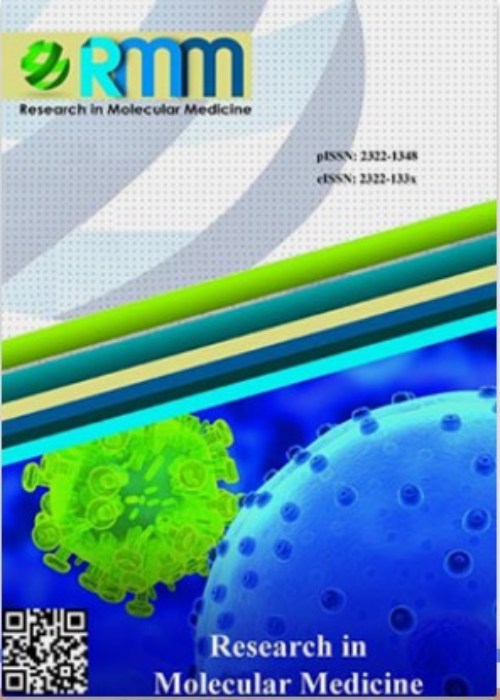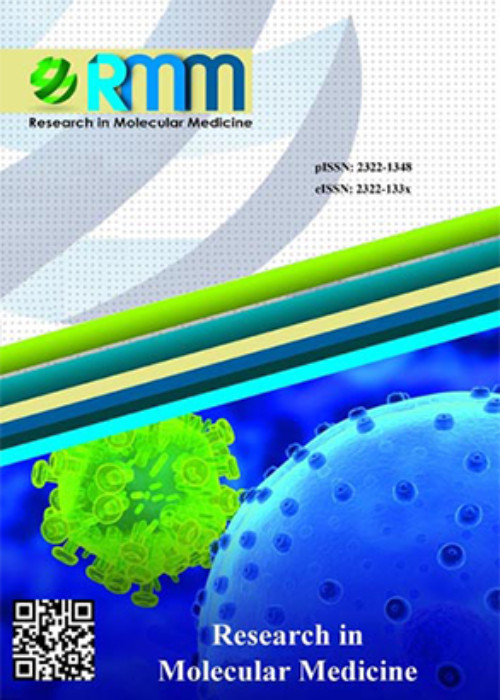فهرست مطالب

Research in Molecular Medicine
Volume:10 Issue: 3, Aug 2022
- تاریخ انتشار: 1402/10/09
- تعداد عناوین: 7
-
-
Pages 115-124Background
Developing cell-based therapeutic methods for differentiating various stem cells into dental tissues could be a revolutionary step toward using cell therapy for dental diseases. In the present study, we systematically reviewed the literature to determine the efficiency of stem cells in treating various dental diseases.
MethodsUsing the search words “stem cell” and “dental disease” as well as all their equivalents and similar terms, we performed a literature search in September 2020 in the electronic databases: PubMed, Scopus, Science Direct, Web of Science, Embase, Ovid, and Google Scholar. The investigation was limited to clinical trials written in the English language.
ResultsOverall, 22 articles with 400 study patients were found and used for qualitative data synthesis. Findings showed that various stem cells with different origins can be used for cell therapy of various dental diseases such as pulp necrosis, traumatic dental injuries, maxillofacial bony defects, impacted third molars, etc.
ConclusionStem cell therapy is an efficient method for treating dental diseases. It can regenerate whole dental pulp and may be useful for treating tooth injuries due to trauma.
Keywords: Stem cell, Bone regeneration, Dental disease, Differentiation, Regeneration -
Pages 125-136Background
Identifying and measuring food pathogens and environmental samples require accurate and high-sensitivity and specific methods. In addition, Salmonella is a zoonotic bacteria that can directly cause human disease. The aim of this work is to develop anti-Salmonella aptamer using bioinformatic tools and enzyme-linked aptamer assay (ELAA) for assessment of affinity and identifying Salmonella.
MethodsThe aptamer sequence is chosen for attach to the surface protein of Salmonella (OmpA). In following, the second and the tertiary structures of aptamer are achieved, using the UNAFOLD and ROSETTA servers. The structure of OmpA was simulated in two methods ab initio (using I-TASSER online server) and homology modeling (using MODELLER software and molecular dynamics simulation). In the next step, the binding of aptamer-protein was assessed via HDOCK software. Then, aptamer and biotin-labeled primers for amplification of specific sequence were synthesized. Finally, the performance of aptamer to detect Salmonella was assessed by streptavidin conjugated with horseradish peroxidase (SA-HRP) using the ELAA method.
ResultsThe results of this study showed that the aptamer, which binds to OmpA, is acceptable with a -283.3 docking score. The superiority of the selected aptamer to random aptamers was also reviewed and approved. After assuring the validation of an aptamer with bioinformatic analysis, the aptamer will be cloned in the pTZ57R plasmid, and then it is used as a template in PCR. After the optimization of PCR and ELAA, the performance of aptamer is successfully carried out for identifying Salmonella.
ConclusionThe designed aptasensor can be used for future investigations to detection of Salmonella.
Keywords: Salmonella, diagnosis, aptamer, bioinformatic analysis, ELAA -
Pages 137-146Background
Low vitamin D has been linked to enhance inflammatory markers in various pathological conditions. We aimed to evaluate the urinary tract infection (UTI)-associated hematological and inflammatory markers mediated by low serum levels of 25-hydroxyvitamin D [25(OH)D].
MethodsVitamin D level, hematological indices (Neutrophil-to-lymphocyte ratio [NLR], Monocyte-to-lymphocyte ratio [MLR], Neutrophil-to-monocyte ratio [NMR], Platelet-to-lymphocyte ratio [PLR], and Mean platelet volume [MPV]), C-reactive protein (CRP), erythrocyte sedimentation rate (ESR), interleukin-6, and tumor necrosis factor-a were evaluated in 115 UTI patients and 57 controls.
ResultsThe findings showed an inverse association between elevated hematological (NLR, MLR, and MPV) and serum markers of inflammation (CRP, IL-6, and TNF-a) with serum 25(OH)D levels in UTI patients. Among the several markers evaluated, the MLR had the ability to suggest the associated inflammation with low serum levels of 25(OH)D.
ConclusionThe involvement of vitamin D deficiency might be characterized by an increase in the inflammatory markers in the patients which have an ability to establish the relationship between vitamin D deficiency and UTI; however, further investigations are needed to validate this finding.
Keywords: 25(OH)D, Cytokines, Inflammation, Monocyte-to-lymphocyte ratio, Urinary Tract Infection -
Pages 147-164Background
Selective serotonin reuptake inhibitors (SSRIs), such as fluoxetine are the firstline choice in patients with post-traumatic stress disorder (PTSD). Animal studies have indicated that chronic fluoxetine exposure leads to persistent behavioral changes and neuroplasticity in the hippocampal formation and cortex. Previous studies revealed that adult female rats respond differently to trauma from adult males. Here, we have raised the question of whether a difference is observed in the response of both sexes to the fluoxetine treatment.
Materials and MethodsIn a rat model of PTSD, the single prolonged stress (SPS) model, rats were exposed to SPS (restrained for 2 h, forced to swim for 20 minutes, and exposed to ether anesthesia) and then were kept undisturbed for 14 days. After that, SPS rats were subjected to chronic treatment with fluoxetine (10 mg/kg -28 days), followed by behavioral (object location memory test [OLMT] and object recognition memory test [ORMT]), and biochemical tests, in which (serum insulin-like growth factor 1 [IGF-1] levels were measured using a Rat ELISA Kit), and the messenger ribonucleic acid (mRNA) expression of anti-apoptotic factor (B-cell lymphoma 2 [Bcl-2]) and pro-apoptotic makers (Bax, and caspase 3) were determined by using reverse transcription-polymerase chain reaction (RTPCR) method and histological assessments by Golgi-Cox staining.
ResultsMale and female rats with PTSD, show a reduction of the levels of serum IGF-1, impaired spatial memory in a recognition location memory task and enhanced apoptotic-related factors expression in the hippocampus, and decreased hippocampal dendritic branches. Fluoxetine treatment alleviated these abnormalities in male and female SPS rats, but fluoxetine had no sex-dependent effects on these factors.
ConclusionOur findings support that fluoxetine treatment can prevent the harmful effects of traumatic events in an animal model of PTSD in both sexes.
Keywords: Fluoxetine, Sex differences, recognition memory, location memory, serum IGF-1 level, dendritic branches -
Pages 165-172Background
The main viral causes of acute respiratory diseases (ARDs) include influenza viruses A and B, respiratory syncytial virus (RSV), adenovirus (ADV), rhinovirus, and parainfluenza viruses (PIV). This study aimed to investigate the prevalence of respiratory RSV, ADV and rhinovirus in patients with flu-like symptoms admitted to Mazandaran province health centers in north of Iran.
MethodsThis study was conducted in Mazandaran province from 21 December 2018 to 21 March 2019. The nasopharyngeal samples were collected from the patients with flu-like symptoms admitted to the health centers. ADV, RSV, influenza virus, and Human Rhinovirus (HRV) were detected by PCR and reverse-transcriptase PCR. Then, the products were visualized by gel electrophoresis on 1.5% agarose under UV light.
ResultsIn the present study, 26 samples (26%) contained the ADV, while 9% and 5% of the samples were positive for RSV and HRV, respectively. Also, co-infection with influenza virus was identified in 12 patients, while 8 (66.66%) patients had a co-infection of influenza virus and ADV, simultaneously. Also, 2 (16.66%) co-infected patients infected by RSV and influenza virus, as well as the rate of HRV co-infection with influenza virus. There were no triple or more co-infections in this study. Moreover, one death was reported among the patients with co-infection of influenza virus and adenovirus, while other co-infected patients were cured.
ConclusionThe findings will help public health officials and physicians to improve respiratory virus infection control strategies. Further molecular monitoring of respiratory viruses should be performed to investigate their epidemiological and clinical features.
Keywords: Adenovirus, Respiratory syncytial virus, Influenza virus, Rhinovirus, reverse transcriptase PCR -
Pages 173-178Background
Severe acute respiratory syndrome coronavirus2 (SARS-CoV-2) has emerged as a global concern. Since its outbreak in December 2019, researchers and authorities have made numerous efforts to identify the disease’s prognostic markers. Changes in the values of coagulation tests are common in these patients. This study aimed to study any possible association between coagulation parameters in COVID-19 patients with prognostic indicators and the disease severity.
MethodsThis cross-sectional survey investigates the CBC, coagulation status, and plasma D-dimer level in confirmed cases of COVID-19 (RT-PCR and/or chest CT scan) admitted to Boo-Ali Sina and Imam Khomeini hospitals affiliated with Mazandaran University of Medical Sciences, in the north of Iran in the last three months of 2021. The tests were ordered at the beginning of hospitalization and discharge. The results included lung involvement percentage, intensive care unit (ICU) admission, and survival.
ResultsOf 140 COVID-19 patients (Mean±SD age: 55.73±16.821 years) evaluated in this study, 51.4% were male. Among comorbidities, diabetes and hypertension were the most common ones. The Mean±SD hospitalization length was 8.47±7.8 days. Also, 56(40.0%), 40(28.6%), and the rest of the patients showed <25%, 25%-50%, and >50% of lung involvement, respectively. In addition, the CURB-65 score for pneumonia severity was low, medium, and high risk for 84, 34, and 22 patients, respectively. The most frequent abnormality among the results was prothrombin time (PT) (17.9%), thrombocytopenia (25.7%), partial thromboplastin time (PTT) (32.9%), and elevated D-dimer level (62.9%). The results showed a significant relationship between abnormal D-dimer levels and poor outcomes, including higher CURB-65 score, higher lung involvement in CT scans, more ICU admissions, and even death. Meanwhile, PT, PTT, and platelet count on admission did not help predict the study population’s clinical course and general survival.
ConclusionDisturbance of coagulation parameters in COVID-19 patients with no significant history can serve as an available and reliable prognostic marker in the patients’ outcomes and clinical course.
Keywords: Covid-19, Bloodcoagulation test, d-dimer, Pneumonia -
Pages 179-192Background
Bioinformatic approaches for designing vaccines have become a promising alternative to conventional methods. We herein designed a multi-epitope-based vaccine against colorectal cancer (CRC).
MethodsUsed peptides in the CRC vaccines were retrieved from databases of PubMed, Web of Science, Google Scholar, and Clinical trials. The adjuvants of Mycobacterial heparin-binding hemagglutinin and pan DR epitope were inserted in the N and C terminus of the vaccine sequence. Physicochemical properties, immunological characterizations, and prediction of the secondary and tertiary structure of the vaccine were evaluated. Linear and conformational B cells were predicted by IEDB. Docking and molecular dynamics simulations were performed between the vaccine and toll-like receptor of 4 (TLR4). In silico cloning and mRNA stability were predicted to evaluate the expression of the vaccine in Escherichia coli (E.Coli).
ResultsThe vaccine contains 368 amino acids constructed from peptides of OGT, FTO, CASP5, CASP8, U2SURP, MED25, FMO5, CEA, and TGFβIIR CRC antigens. The vaccine has a high-quality structure and suitable physicochemical and immunological properties. It has large and accessible B-celll epitopes. Docking and molecular dynamics simulation of the vaccine with TLR4 showed an appropriate and stable interaction between the vaccine and immune receptors. In silico cloning showed the vaccine can transcript and translate in E.Coli as a host.
ConclusionThe CRC vaccine is immunogen, non-allergen, and structurally stable. In the next step, the in silico results of this study will verify using in vitro and in vivo studies.
Keywords: Colorectal cancer, Tumor biomarker, Bioinformatics analysis, Multi-epitope-based vaccine


